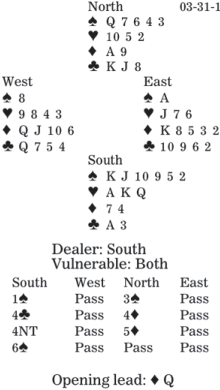 |
|
[Picture/ China Daily] |
Samantha Stosur, an Australian tennis player who won the US Open women's singles in 2011, said, "It was a lifelong dream to win a Grand Slam, so when I was able to do that, it felt so good and I wanted to do it again. It's not that hard to stay motivated."
Inexperienced bridge players who bid a slam quiver like Bertie Wooster when faced by his Aunt Dahlia in the wonderful books by P.G. Wodehouse. One fear is that if you go down in a slam, a game bonus has just gone out of the window. But as we gain experience, we reach a slam and feel as excited as a young child who has just learned to ride a bicycle. Also, the play is not normally difficult.
When thinking about bidding a slam, you need to consider three important factors: combined high-card power, trump fit and controls (aces, kings, voids, singletons). In today's deal, North-South have only 28 points, but with an 11-card fit and the necessary controls, six spades has play.
Over three spades, South control-bids four clubs, showing the club ace (or a void). When North rebids four diamonds, indicating the diamond ace and slam interest, South uses Blackwood, then signs off in six spades.
How should South play after West leads the diamond queen?
South must try to eliminate his diamond loser immediately. He cashes his club ace, plays a club to dummy's jack, and discards his last diamond on the club king. Then he drives out the spade ace and claims.


























 Raymond Zhou:
Raymond Zhou: Pauline D Loh:
Pauline D Loh: Hot Pot
Hot Pot Eco China
Eco China China Dream
China Dream China Face
China Face






